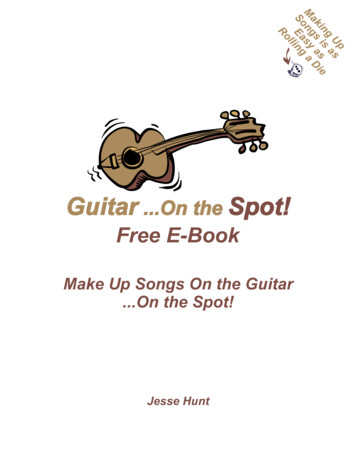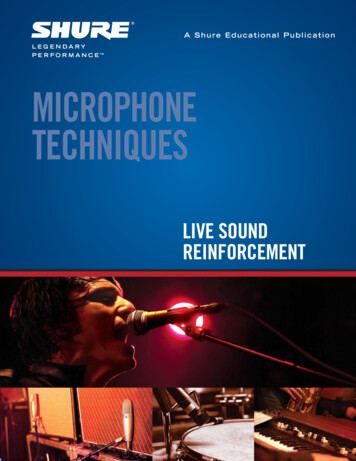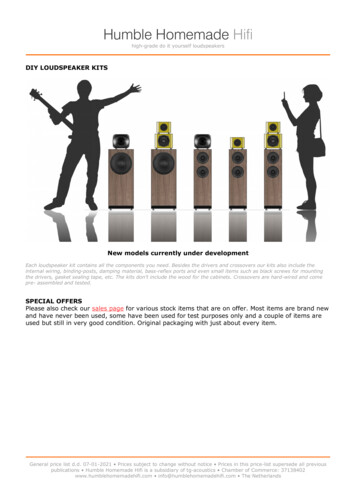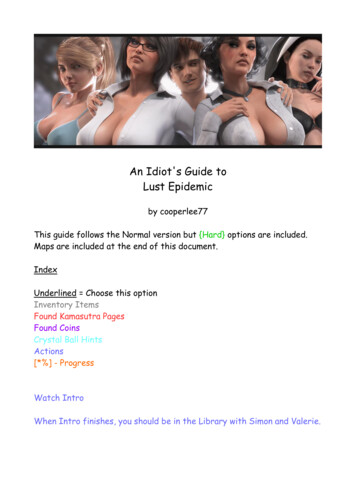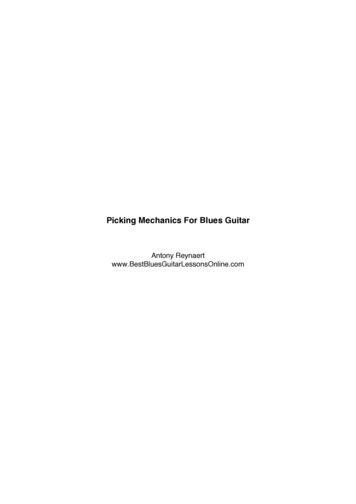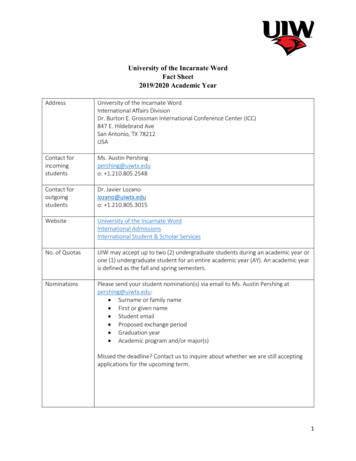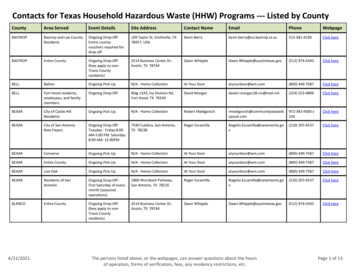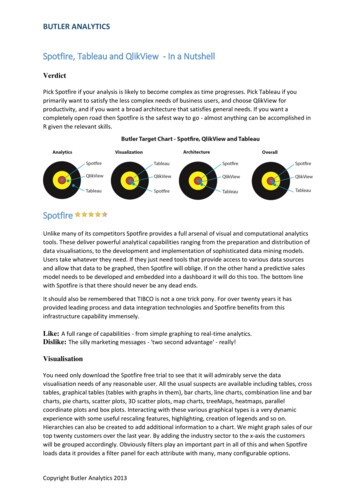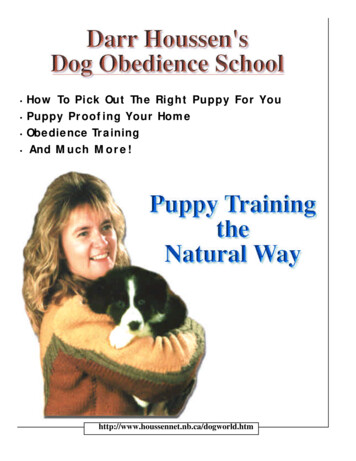
Transcription
How To Pick Out The Right Puppy For You Puppy Proofing Your Home Obedience Training And Much More! http://www.houssennet.nb.ca/dogworld.htm
p2Darr Houssen’s DogObedience SchoolIntroductionWelcome to the fun, fantastic, thrilling andIncluded in this puppy manual are such topics as:challenging world of puppy rearing. From verypersonal experiences I can vouch for all of theabove emotions plus a few more as well. You arein for what could be one of the most rewardingexperiences of your life. Within this publication, Ihope to offer you some simple, down to earthmethods and techniques to help you along inyour journey. Some ideas you may have heardof before, some you may not. Remember, theremay be more than one answer or solution for anyone particular question or problem that arises.Consideration has to be given to your puppy’sbreed, personality, purpose of that particularbreed, physical size and body structure whenapplying a method. I will give you as manyoptions as I can in the various topics followingthis introduction section. How to pick out the right puppy for you. Pre-preparations before the puppy comes home. Puppy proofing your home. Housebreaking. Biting or nipping. Proper and appropriate “Toys.” How to make these “Toys” work as teaching tools. Accurate corrections Discipline. Energy burn off Training equipment.We stick to “Mother Nature’s” methods of correction and praise when dealing with puppies ordogs since this is the language they will immediately understand, comprehend and respect.Mother Nature’s way as we have seen fit to termit, works for all breeds. The intensity of thismethod will vary from dog to dog. You will learnmore about this unique method we have studiedas we progress. Why Mother Nature’s method?Simply, there has been over the years as manymethods developed by different trainers as thereare fads from the Beatles of the 60’s to disco ofthe early 80’s. We are not saying that thesemethods don’t work but we choose to use themost natural of all.and of course.OBEDIENCE TRAINING .soyour puppy learns at a very early age to be an acceptable member of the family and reliable companion dog.You must keep an open mind when dealing with yournew puppy. Patience is crucial but you must also thinkabout the method that will best work for your specificpuppy’s personality. Just as all people are different incharacter, so are puppies. What works with one pupmay need to be adjusted a bit to suit your own puppy.The important thing to remember is to discipline thepuppy for an inappropriate behavior and love them topieces the moment the behavior is altered.Just as the human child goes through various stages ofdevelopment, so does a puppy as it matures towardsadulthood. (ie. infant, toddler, elementary, adolescence, puberty and finally adulthood.) Good luck, havefun with your new puppy. The first five months will goby very quickly so start as soon as possible down thatroad of mutual “RESPECT” between you and yourpuppy.
Picking The Right Puppy For YouFirst and foremost, it’s a great idea to researchthe various breeds you are interested in. Thegeneral look that interests you is a good place tostart. For example, if you prefer a breed withstand up, perky ears, then you should eliminatethe floppy eared and cropped ear breeds. Thenyou must decide for what purpose are you acquiring a dog. Will it be a house dog when mature,laying at the foot of your bed, or on your bed, orout on the doorstep being a guardian? Will youhave the extra time if the breed requires extrarecreational playtime? Are you willing to put thetime into grooming that some dogs require, especially the ones with the long hair? Once you’venarrowed the choices down, your next job is tolocate a reliable breeder. One good breederresource is to contact a few kennel clubs in yourarea. Ask them for a breeder referral list for thebreed of your choice. Contact by telephone ismore courteous and can give you a valuable andnon threatened first impression than dropping inon the person or facility unexpected. Theseshould be good, reliable breeders but don’t beafraid to ask for names of previous buyers.Remember, any good breeder will check out theirpotential puppy purchasers before releasing apup into their hands. This is a very commonpractice. Next, set up an appointment to go tosee the litter and if possible both parents. Theywill give you a general idea of what you canexpect from the puppy as an adult as far as thelooks and size go. The breeders facility shouldbe clean but keep in mind if you are going to seea litter of 10 German Shepherd puppies, you maysee an unscheduled poop spot or pee puddle.First observe the puppies while standing backfrom the whelping box or kennel area. Watch tosee which ones are pushy with their litter matesand which ones are content to observe from thecorner. Which ones roughhouse play? Whomakes the others cry by biting too hard in play?This puppy could be the tough guy or gal of thelitter.or the ALPHA puppy. This would not be agreat choice for a family with small children orfirst time puppy owners as it could want to controlthe family household and members. Ask thebreeders if they could isolate the alpha puppy soyou could observe the rest in a more fair environment. Now you are at the stage of deciding:Male or Female.p3Darr Houssen’s DogObedience SchoolOnce you have your puppy home, you will start todevelop its personality the way you want. If you knowwhich sex you want, ask the breeder to put the othersex away to give you time to observe all the males orall the females. Don’t pick a particular puppy justbecause it is the cutest! There are easy tests you cando yourself to help you determine the best choice foryou. Watch them to see which puppy is watching you,making direct eye contact with you. Take a couplesteps backwards away from the puppies and lookclosely at who moves with you. Next, take a few moresteps from the group and clap your hands, snap yourfingers or verbally call to encourage the puppies to follow.Open your arms in a wide fashion and call to the puppies in a higher pitched voice. Again, observe the followers. These pups would be the ones interested inhuman beings, thus making good companion dogs.Narrow your choices down to 2 or 3 from those coupleof little tests. Next, take each puppy in your hands.Balance it’s weight by supporting it under the rear andon the chest. Observe the pup’s reactions at this point.Is the pup struggling to break free, growling or showingit’s teeth. These are negative signs in inexperiencedhands and definitely need to be corrected very early inthe pup’s life. If the pup is comfortable and relaxed,maybe even licking your face or hands, then those arepositive signs and those of a more submissive puppy.Another quick test is the “rollover test” where you gently roll the pup over in your arms into a cradle position.Again the pup should be calm and relaxed. If not, try asimple growl correction to test the pups submissionlevel. If it quickly freezes in a still position, that meansthe pup will probably accept human discipline easily.However, if the struggle continues, be prepared forsome headstrong behaviors in the future. After socializing with each puppy a few minutes, place it backdown on the floor and repeat the “walk away and followme test”. Observe the pups for the quickest reaction toyour leaving them. The quickest one to follow youcould be the strongest bonding potential puppy fromyour choices. Repeat the procedures as a doublechecking system. If you’re happy with the results andthe pup is attractive to you, then that’s the one for you.
PUPPY PROOFINGYOUR HOMEp4Darr Houssen’s DogObedience SchoolFor the first couple days when you first bring your new puppy home, it probably won’tget into too many dangerous situations, but once he feels a bit at home, brace yourself,the curiosity level will start to overcome your sweet little puppy. Therefore, some preparations around your home need to be taken to insure safety for the pup and your belongings. Usually, a veterinary clinic can provide a list of poisonous house plants. Certainones can be deadly to your puppy. The movement of the leaves of the plant is very motivating to your puppy, so it’s a best bet to move all plants out of his reach, especially in therooms where the pup would be unsupervised. Also, Place all breakable or valuable ornaments or treasures up out of his reach. Removing the items eliminates the possibility offrustration and destruction of these articles, however if you choose to leave them withinreach, you must be prepared to make the appropriate corrections when the pup investigates. For correcting the pup for handling inappropriate household articles, I have foundthat sound and voice corrections work the best. When you see your pup interested orinvolved with an off limits item, stomp your foot, or clap your hands and use a very sternand growly “NO” command. The pup almost always will immediately stop the behaviorand look at you providing you do the correction properly. If he’s not leaving the item, thenyou must go to him and remove him from it. Urgent tones in your voice are usuallyenough to distract the pup from his own curiosity interests. However, if you’re short ontraining time or patience, perhaps the prevention method would be best for the earlystages of the pup’s home life.Puppy ProofingSoftclothing articles like sneakers, leathershoes, socks and other assorted undergarmentssimulate soft animal like objects that are irresistible to your puppy. To a puppy, these are playitems that if left laying around, are there for his orher enjoyment, so prepare the family members tokeep things off the floor as they are fair game tothe pup. Now remember we are talking about apuppy. As the dog gets older and starts bonding,these items begin to replace your presencewhen you are not home due to a stronger humanscent that accompanies these items. Of course,there are many, many household items that needto be removed from the puppy’s reach. Itemssuch as pin cushions, sewing needles, householdcleaners, soaps, candy dishes, pens, pencils,thumb tacks, paper clips, yarn, paint, modelingclay, crayons and the list goes on and on. Puppyproof your home for your new puppy in the sameway as you would for a toddler aged child.That would be the best guideline anyone could giveyou. Decide where you would like the puppy’s bed tobe. If you choose the mat beside your bed, that’s fine.If the laundry room is your choice, that’s OK too. Theimportant thing is to have a plan before the pup comeshome. Gather a few old blankets or large towelstogether so that you have a reserve stockpile to pullfrom. Don’t choose your next to best linens (to honorthe new arrival), as the puppy will probably eat them orat least chew interesting patterns in them. All puppieschew. It’s nature’s way of reducing painful cutting andgrowing of baby teeth. They also chew to relieve stressfrom built-up energies within themselves or from simpleboredom. Depending on the breed you choose, puppies will chew anything, from toilet paper to gyp rock orwallboard. Preventative measures are the bestmethod of correcting the problem, which leads us intothe next topic of toys.
Proper andAppropriate ToysYou will find it very handy and convenient tohave a toy box or basket in each room that thepup spends the majority of it’s time in. (i.e. Livingroom, family room, kitchen, bedroom, or the roomwhere the pup sleeps.) One of these entertainment boxes may not be needed in all rooms, butcertainly the most frequently used rooms do.Four or five articles in each basket is a good plan.The puppy needs a variety of textures and sizesto vent out different areas of canine instinct. Forexample, soft , plush type toys simulate smallmammals to your puppy.Remove the toys eyes &noses for safety. If the pup was still with it’s mother instead of with you, she would be teaching ithow to stalk, hunt and even perhaps ingest smallmammals to survive. Those instincts are stillactive even though we humans provide them withan expensive, balanced diet. Therefore byallowing them to have access to furry, little stuffedtoys it enables them to vent this natural instinct.You may see your puppy stalk or sneak up on thistype of toy, then pounce on it, play with it by tossing it around the floor or through the air thenpounce on it again. They can spend several minutes on this procedure at one time and literally behaving a ball. They will mouth the object andmay even shred it pretending to eat it. If this happens, remove the article and give him another.Certain breeds of dogs will exhibit this behaviormuch more than others, so experiment a bit withyour individual puppy. Most puppies tend to gothrough several of these stuffed toys during theteething months so I suggest picking up severalfrom garage sales, yard sales or second handlocations to keep the costs down. Rawhides area good pacifier until the puppy starts eating themlike candy sticks. When the puppy is under 6months he probably will use them up slowly, butonce the adult teeth come in, cut back on theamount you’re allowing him, as this could lead todigestive problems. Rubber toys inp5Darr Houssen’s DogObedience Schoolvarious shapes are available on the market as well.These come in all shapes and sizes and make superentertainers. Of course, no toy box is complete withouta ball of some sort in it. Tennis balls, the orange ballhockey balls, soccer balls, footballs and big soft baseballs seem to be favorites to the medium to large sizesized breeds. For the smaller breeds, squash balls andtennis balls seem to be their favorites. Certain breedslike border collies, labrador and golden retrievers, etc.seem to enjoy Frisbees as toys. This is not necessarilya favorite of all pups. Without access to the items mentioned above, your puppy will find his own toys amongstthe families belongings. This could include slippers,mats, shoes, cushions, couches, chair legs, cushionflooring, woodwork, etc. We have all heard the horrorstories of people coming home to find that “FIDO” atethrough their living room sofa. Why? Because he hadfree access to it, plus a reserve of energy that needed tobe burnt off and no toys were left out for him to devourwhile mom and dad were at work.How to use these toys asTeaching ToolsTry to keep in mind during your interactive playtimeswith the pup, that every action, word or command carried out can become a valuable part of the pup’sschooling and education. For example, simply tossinga toy for the pup actually has the potential to teach yourpuppy to retrieve on command, recall or return to youon command, sit on return to you and give up the article without a struggle or fight. All of these situations arebasic, meaning that the pup will use these commandsover and over again all through its life. The earlier youstart to focus the pup on these commands, the easieryou and puppy will slide through the puppy months.
Breaking Down The SegmentsOf The Retrieving Exercise:1. Have a flat leather or nylon collar on your pupfor this type of session. You also need a 30 to 40foot energy burn off rope, (if playing outdoors) andattached to his collar (See energy burn off in topic#5). This is crucial to insure a safe playtime andaccurate training session s well.2. Next, get the puppy excited over the toy or article. Toss it out a couple of feet from where you areto warm the puppy up. Command to the puppy“Take It”, (while it is still moving), using a fun andenergetic voice. As soon as he takes the article,turn and start running from him so that he has torun to catch you. Start off by making these catchup distances quite short, about 10 to 20 feet. Ashe’s closing in on you, turn and face him, calling outhis name and the command “COME“. Coach himwith lots of “GOOD PUPPY“ praise.3. When he’s almost to you, bend down to his levelwith open arms. Remember, if the pup gets toosilly or out of control at any time, the long line isthere to reinforce your commands. Should herefuse to come to you, simply reel him in like a fishline and praise heavily with voice and hands whenhe gets to you.4. Once within arms reach, command “SIT“ to thepup. If he’s facing you, lean forward over him whilehe’s still in the we are having fun frame of mind. Ifhe still resists, just apply a bit of pressure on theindent spots near his hips. (Feel along the pupsbackbone and just before the hip bones you willfeel 2 indent areas. Place your thumb in one andyour middle finger in the other, on the oppositeside. These I refer to as the indent spots). Do notpress straight down or firmly. Your puppies bonesare growing and you don’t want to put unnecessarypressure that could perhaps contribute to futureproblems. Rather then pressing, guide the puppiesrear end back and down in a 45 degree mannertowards the floor, into a sit position.5. Once in a “SIT“ position, command “GIVE“ tothe puppy. Now most puppies want to hang on tothe article and start the tug- of- war process. If thishappens just pry his mouth open, using your thumband middle finger over the top of the muzzle. Pushhis own lip in-between the jaws and guaranteed,your pup will gladly spit out the article. Thismethod eliminates the possibility of the pup puttingtremendous bitep6Darr Houssen’s DogObedience Schoolpressure on one of your fingers while teaching him thecommand “GIVE“.6. On the release of the article, instantly give tons of“verbal and hands on praise”. Repeat the process afew more times gradually adding a bit more distancefor the recall each time.7. Depending on the breed that you have will determine the number of repetitions you need to do in asession. (i.e. a border collie can go on endlessly,where as a laid back personality may only tolerate 2or 3 reps at one time.) The most important thing toremember is to keep this playtime fun for both you andyour puppy. Stop when either of you have had enoughso that neither party sours on the activities. There isnothing wrong with teaching the puppy the “ENOUGH”command. This is another verbal, growl type of command that your pup is familiar with as he has heard itfrom his mother at very early stage. When she had“ENOUGH“ of the puppy silliness, she would growl ina disciplinary tone that basically told the puppy to backoff and entertain itself for awhile. Hence the reason forthe growling tone.Now a good tug of war game is lots of fun for yourpuppy, However there is a right and wrong way to playthe game. You can play tug of war type games withyour puppy, if the article is a doggy type article. Not thetowel off the kitchen stove. You see, you must win atthe game and the trick to success is to force the pupto release the article to you with the “GIVE“ command,then toss it away and allow him to retrieve the articlehimself. If you were to give in and release the articleto the pup in the heat of the game, then you are teaching him that he is stronger than you, both physicallyand mentally. This is a terrible foundation to start thetraining process from. He would already disrespectyou as a strong leader in his eyes. If you choose toplay this game, ensure your winning then return thearticle to the pup for his use and amusement.Otherwise, avoid the game altogether.
ENERGY BURN OFFMost all puppies have big bursts of energy atone time of the day or another. These energyburn off times can be a positive or negative experience. Lets analyze the positive first.If an energy burn off comes up when you are athome with your pup, it can provide you with anexcellent opportunity to structure some really funand educational use of a playtime. The results ofthis type of session are easy training, fun learningplus the added bonus of a tired out pup at the endof it all. A tired pup is a quieter and less destructive pet in the house. For this reason, I recommend working owners or busy families, to try at allcosts to have an energy burn off session with thepuppy before leaving for the day. Even 5 to 10minutes will make a tremendous difference. Thenplace your puppy in the most puppy-proof room orspot available in your home. A garage is OK if ithas been completely puppy proofed and the temperature is reasonable for your particular breed.Provide lots of chewy things, and an old blanketor towel. (OLD so that when you come home andfind it shredded you can laugh as you sweep itinto the garbage and replace it with another oldone.) Remember, what you give him in thatrestricted area is his, so don t leave anything youare too attached too. Playing a radio also helpssoothe the puppy and give him a feeling of notbeing left alone. Someone really should try toexercise the puppy at least every 4 hours if possible. In some situations this is impossible, butdon t feel guilty. Your pup will adjust to whateverlifestyle you provide for it. Perfection is not whatis important to your pup. Your mutual love and hisrespect for you are what really count. Now youactually have to have respect for your puppy aswell but, don’t forget you are the master, not thepuppy. Like your children, you love them andrespect their space but you still are the parent.And, to be sure, kids should love and respect theirparents. At least that is the ideal situation.Ordinary walks are good for your pup but theseare not energy burn off where the pup rips andtears around at full speed, being himself, a silly,clumsy, typical puppy.NEGATIVE ENERGYBURN OFFThese are definitely not fun for you but your puppywill have a real ball. This type of energy burst happenswhen you have not removed the stored upreservesbefore leaving the puppy alone. Your puppy becomesvery creative in his method of energy release. Even ina confined area like a laundry room or a kitchen, he willfind all kinds of things to amuse himself. Things likechewing on baseboard or door frames, lifting up orshredding the cushion floor, clawing window frames ortearing curtains down. Do you see the picture. Not apretty one at all. Probably for this reason, many puppies are given up, sold or placed in humane shelters forbehavior that is really not their fault. Just simple lack ofknowledge on the owners part can destroy many goodpups. Can you imagine what giving free-roam to awhole house would do to a puppy energy burn off time.Pretty great party for the puppy but beyond comprehension for the owner. (How could our beloved FEEFEE do this assault to the couch when we love her andtrust her with the whole house to live in.) POSITIVE ORNEGATIVE. It’s really up to the owners to provide theproper direction for the puppy.HOUSE BREAKINGIt is a good idea to find out if possible , exactly what thepuppy s environment was before you brought himhome. This will tell you what the puppy was accustomed to messing on in the early stages of life. (i.e.was it a newspaper litter box style, sawdust or shavingsas in a barn or pet store, cement floor as in a kennelrun, or maybe a grass bottom playpen.) This information will help to determine what will immediately workfor your puppy. The most common method of housebreaking is paper training. When using this method,you will need to spread papers, a couple layers thick ina certain area of the puppies most used room in thehouse. Also, you will need to spread some newspapers in the area of the yard where you want the puppyto make his bathroom. (of course weather permitting)Weight these down with rocks or bricks in the beginningstages.continued on next page.p7Darr Houssen’s DogObedience School
.continued from previous pageTry to not allow the puppy to have access to thewhole house as this is just too much territory forhim to be able to handle in the early stages. Thisonly reinforces long term housebreaking.Gradually over the first 4 months, after you havebrought him into your home, can you start allowing him access to other areas unsupervised.When you catch the puppy in the act, but missingthe papers, gather him up in your arms, scold himwith a growling BAD PUPPY, OUTDOORS, takehim outside to the designated bathroom area. Dothis quickly. Move quickly so your body languagegive the right message to the puppy as a sense ofurgency. Set him down on the ground and repeatin a command voice “Hurry up!” “Hurry up!” Youcould use other words rather than hurry up, wordsof your personal choice, but hurry up sounds better than “pee pee”. Especially if your in a publicplace. When the puppy has done it’s duty, andonly then, start to praise. “Good boy/girl!”,Outdoors -this is spoken in a praising tone. Evenif the puppy has finished inside the house, praisehim anyway. You are relaying to the pup thatmessing in the house is bad, messing outside isgood. If your puppy doesn’t t do anything after 5minutes, pick him back up and bring him backinside with you. Supervised housebreaking withproper correction and praise will be much moreeffective then if puppy is left outside alone afteran in-house accident has occurred. With puppyout of sight, clean up the mess with paper towelsto remove the access and then deodorize thearea with an a neutralizer cleaner available atmost veterinary clinics or pet stores. If the puppyis present during the cleanup, he will sense yourhostility again and become confused. The positive reinforcement with praise outside could belost.Helpful Hints to makethe task easier:1. When your puppy wakes up from a nap, evena 5 minute snooze, almost every time he will haveto relieve himself. Gather him up in your arms andtake him outside to his spot. Repeat the wordOUTDOORS to him as your on route to the spot.Place him on the newspapers or prepared areaand wait.p8Darr Houssen’s DogObedience SchoolHe may move onto a grassy area near the papers.That’s super, that’s the goal. Encourage him with thekey phrase that you want to use every time as “Hurryup”. Whatever term you use, just be consistent. Do notpraise with Good boy/girl until the pup is completely finished, then lay on the praise and continue on your way.Use this procedure after a playtime, meal, nap, confinement or first thing in the morning and last thing atnight. Keeping a pair of slip on shoes by the door willmake an emergency exit more effective for you and thepup.2. Keep your puppy on a feeding and watering schedule. The best method for puppies 6 weeks to 4 monthsis to feed 3 times a day if possible. Early morning, latenoon, and again in early evening (6 to 7). Allow himaccess to water during feeding times but restrict theamount so he does not intake too much and becomestuffed or bloated. This could lead to a serious intestinal situation, requiring veterinary help. What he leavesin his food bowl, pick it up and place it out of his reach.About 1/2 bowl of water could be left with the pup fordrinking between meals. His body will adjust to a feeding schedule very quickly, therefore making housebreaking very predictable. Simply realize that thepuppy will have to relieve himself within 5 minutes afterhe eats so be prepared to make the trip outside to hisspot. Be consistent with the scheduling and the task ofhousebreaking will be much quicker. If you need tochange the puppy’s food type, it is very important thatyou do it gradually slowly adding the new type to theold, small amounts at a time. Your pup could becomeill if the change is made too quickly.3. Crate training or room confinement of your pup whileyou can t be there will greatly help your goal of housebreaking. At first you may feel this is a mean gestureon your part but it actually can be the opposite for yourpuppy. He actually regards the crate as a den or his private territory. Two to 3 hours at a time is a long enoughtime span. Once accustomed to it, puppies will oftenretreat to their special den for a nap time even whenyou are at home. Do not feed or water the pup in hiscrate, however, do leave several small toys in there forentertainment and companionship. Most puppies willnot eliminate in their sleeping quarters so they learn tohold on until they are taken out side. If a crate is not inyour budget, use a small room like a laundry room,washroom or barricaded off den or kitchen. A wholehouse is just to much for puppy to respect in the early
4. When your puppy does get into a mess or doesan undesirable behavior, no matter how cute he isin the situation, DO NOT LAUGH AT HIM. Thiswill encourage him to do it again because he mayinterpret it as a positive attention getting action.Discipline the puppy first then afterwards whenyou are sure the puppy has an understanding thatwhat ever happened wasn’t a good thing, you cangently and slowly give soft pats and gentle hugs.As if to say, “I still love you but don’t do it again”.Don’t get real excited and have too happy a faceor the puppy may not get the feelings of your trueemotions. Remember your puppy is reading bodylanguage as well as the tone of your voice andeven perhaps the few words he is starting to catchon to. They do learn quick and what you wish toaccomplish here is a level of understanding andrespect on the learning puppy’s part.5. If your puppy is frantically struggling with you,perhaps he needs a break from the play or training, so a trip outside to his spot is in order.Biting or NippingAlmost all puppies want to bite, chew or nip attheir owners hands while they re being handled.This would be a normal behavior if still with his litter mates because this is part of the process ofdetermining the pack leader within the litter. It isnow up to you as the puppy’s new master tobecome the pack leader in his eyes. This will nothappen by accident. You must begin at a veryearly age to establish the order of the pack withinyour own household. When your puppy growls atyou or grabs your hands or fingers, immediatelygive him a scruff of the neck correction and a verystern growling command, “NO”. The scruff ofneck correction is taking the back of the pupsneck in your hand, give a stern shake and suspend the puppy 1 or 2 inches off his front feet fora few seconds, then gently easing him back to 4feet on to the floor. Calmly praise him as thenasty beha
puppy for an inappropriate behavior and love them to pieces the moment the behavior is altered. Just as the human child goes through various stages of development, so does a puppy as it matures towards adulthood. (ie. infant, toddler, elementary, adoles-cence, puberty and finally adulthood.)



